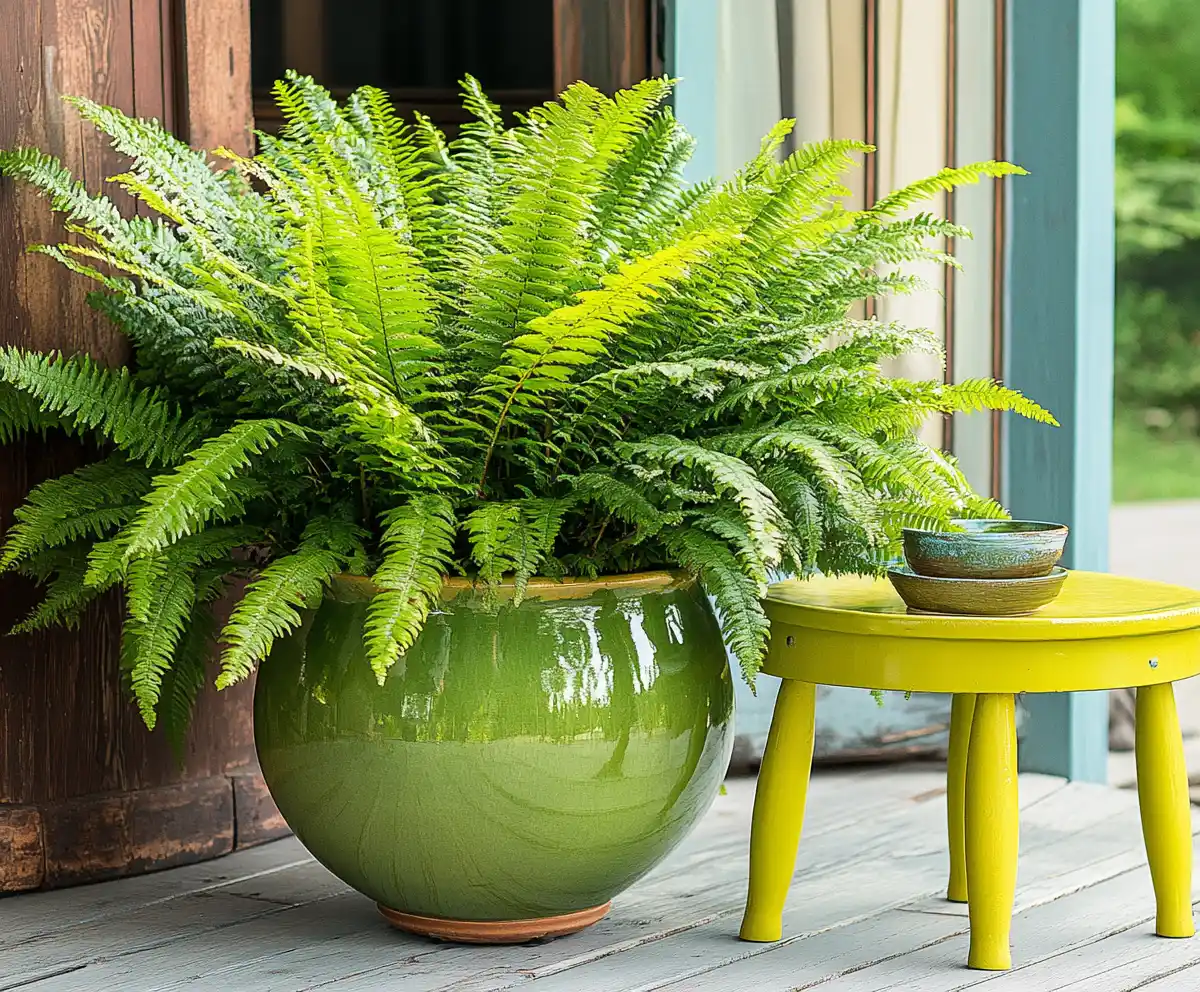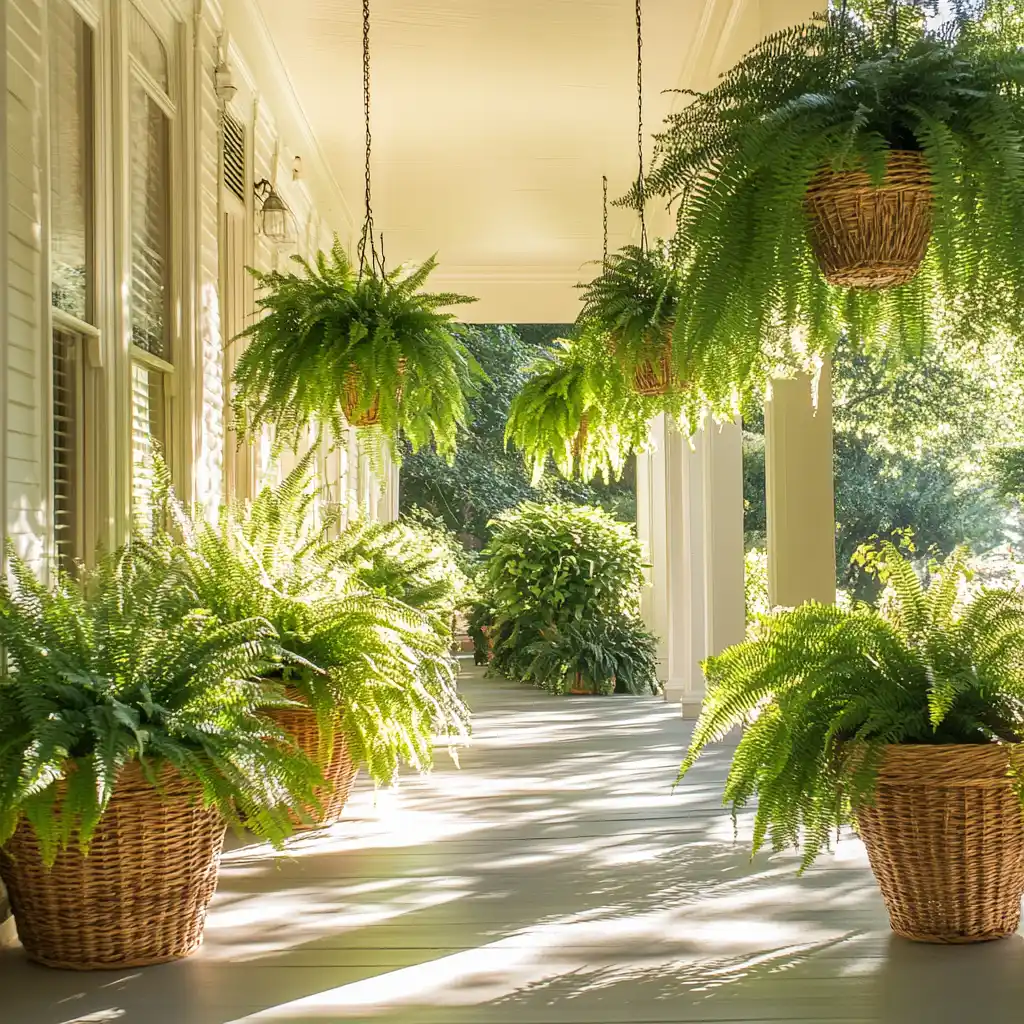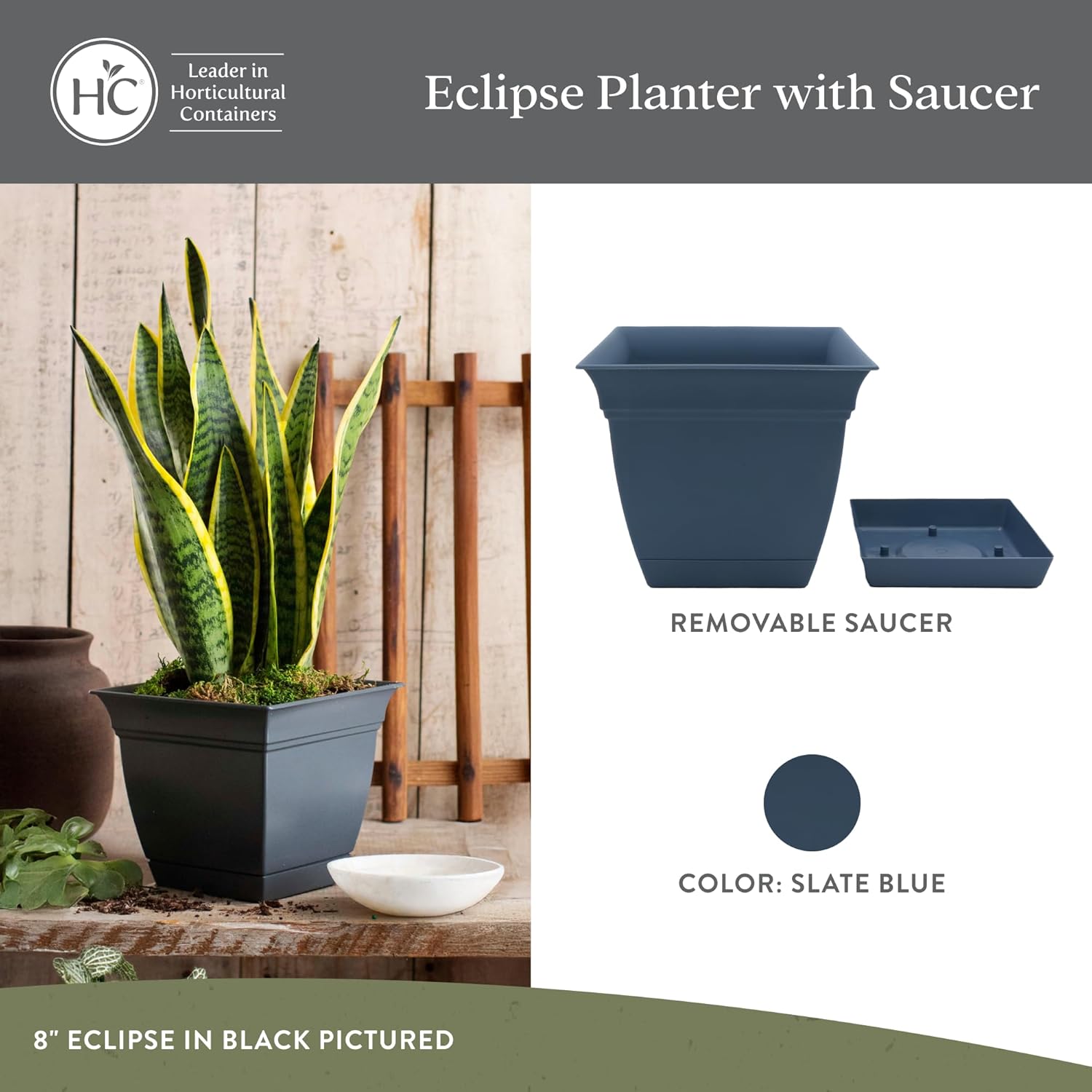Adding lush greenery to your porch or patio doesn’t have to be complicated — especially when it comes to outdoor fern care in pots. Ferns are prized for their delicate, feathery fronds and timeless beauty, making them a go-to choice for both beginner and seasoned gardeners alike. If you’re enhancing a shaded balcony, updating your summer front porch decor, or looking for stylish planters for your front porch, ferns can add soft texture and vibrant greenery to your space.
In this complete guide, you’ll discover six expert-backed tips for mastering outdoor fern care in pots. From choosing fern varieties that thrive in your climate to perfecting your watering and light conditions, these strategies will help your ferns flourish in containers all summer long — no matter your gardening experience. Plus, we’ll share easy ways to pair your ferns with shade-loving flowers for a truly lush and inviting patio display.
Table of Contents
1. Select the Right Fern Type for Your Climate Zone
The first step to successful outdoor fern care in pots is choosing the right type of fern for your local climate. Not all ferns are created equal — some thrive in humid southern zones, while others are better suited for cooler regions. To make the most of your container garden, it’s important to match your fern’s needs with your USDA hardiness zone.
Top Ferns for Pots and Containers
- Boston Fern (Nephrolepis exaltata)
A classic favorite for its arching fronds and soft texture, Boston ferns love bright shade and high humidity. They flourish in zones 9–11 but can be grown as seasonal container plants in cooler zones. Ideal for hanging baskets or elevated planters where their foliage can drape gracefully. - Kimberly Queen Fern (Nephrolepis obliterata)
Known for its upright, sword-like fronds, the Kimberly Queen is both low-maintenance and heat-tolerant. This fern is a great choice for sunny porches with morning light and filtered afternoon shade. Its vertical growth makes it perfect for narrow entryways or flanking doors. - Macho Fern (Nephrolepis biserrata)
True to its name, the Macho fern brings bold texture and impressive size. These ferns can grow up to 6 feet wide in warm, humid climates. Best grown in zones 9–10, they thrive in large pots or oversized baskets with plenty of room to expand.
💡 Tip: Not sure what your growing zone is? Use an online USDA Zone Finder tool to determine which ferns are best suited for your region.
2. Place in Ideal Light Conditions (Bright Shade)
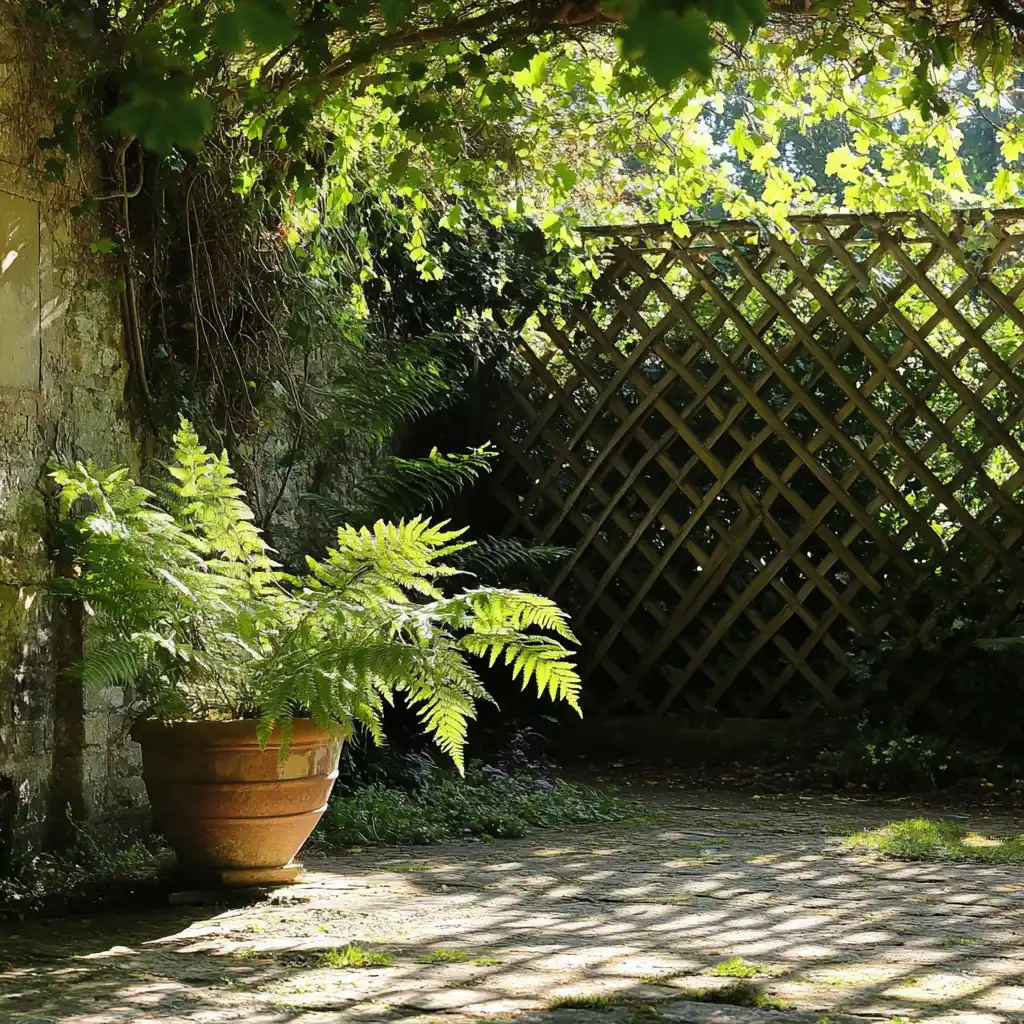
One of the most important elements of outdoor fern care in pots is getting the light right. While ferns are shade-loving plants, they still need plenty of bright, indirect light to thrive. Too much sun can scorch their delicate fronds, while too little light may lead to sparse, leggy growth.
How to Find the Right Spot for Your Ferns
- Avoid harsh midday sun: Direct sunlight, especially during the afternoon, can cause your fern’s leaves to turn yellow or crispy at the edges.
- Aim for morning or dappled light: A porch with eastern exposure or filtered sunlight through trees is ideal. Think soft, gentle light — the kind that mimics a forest floor.
- Don’t tuck them too deep in the shade: Ferns still need light to photosynthesize. If your porch is very dark, consider moving your pots a bit closer to the edge or using a reflective surface to bounce light.
🌿 Pro Tip: If your fern’s fronds look dull, pale, or sparse, it may be a sign they’re not getting enough light. Try relocating the pot to a slightly brighter area and observe changes over a week.
3. Use Well-Draining Pots and Soil
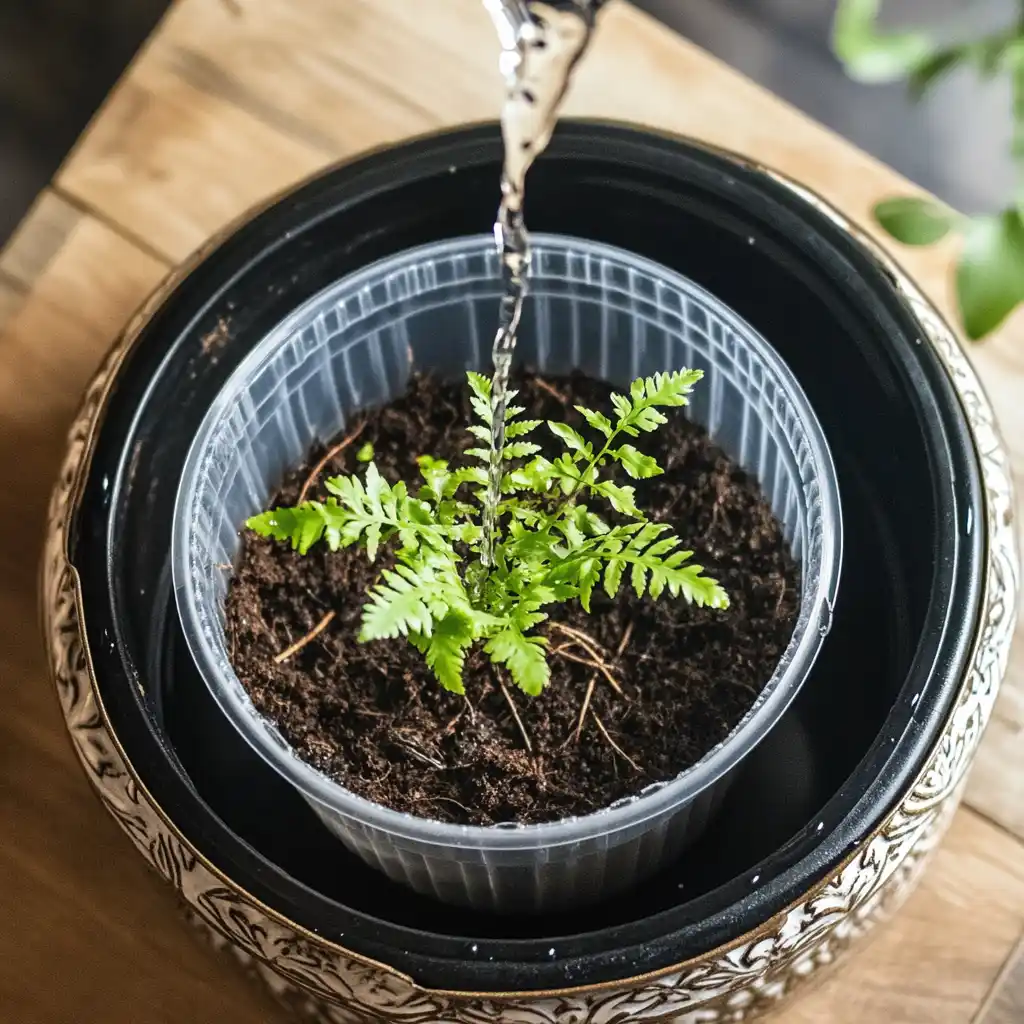
For effective outdoor fern care in pots, selecting the right containers and soil mix is just as important as proper watering and lighting. Ferns are particularly sensitive to excess moisture around their roots, so ensuring your pots have excellent drainage is key to preventing root rot and other water-related issues.
Why Well-Draining Pots Matter
- Prevents Overwatering Hazards: Ferns need consistent moisture, but sitting in waterlogged soil can damage their roots. Containers with drainage holes allow excess water to escape, maintaining a balanced soil moisture level.
- Retains Necessary Nutrients: Good drainage facilitates proper air flow around the roots, which helps the plant absorb nutrients and maintain its overall health.
- Flexible Aesthetic Options: While the original nursery containers are designed for optimal function, you can often nest these within decorative pots to blend gardening practicality with visual appeal.
Tips for a Perfect Setup
- Use a Two-Pot System: Consider keeping your fern in its original plastic pot, which is designed for proper drainage, and then placing it inside a larger, decorative container. This way, you achieve both effective growth conditions and enhanced aesthetics.
- Choose the Right Soil: A lightweight, well-draining potting mix is ideal for ferns. Look for mixtures formulated for container plants or create your own by combining peat, perlite, and a touch of compost.
- Check Regularly: Periodically inspect your pots and soil to ensure that drainage remains unobstructed and that the soil isn’t compacted or retaining too much moisture.
By choosing the right container setup, you’ll provide your ferns with the optimal conditions they need to grow lush and beautiful, ensuring your outdoor fern care in pots is both effective and visually appealing.
4. Fertilize Regularly with Epsom Salt
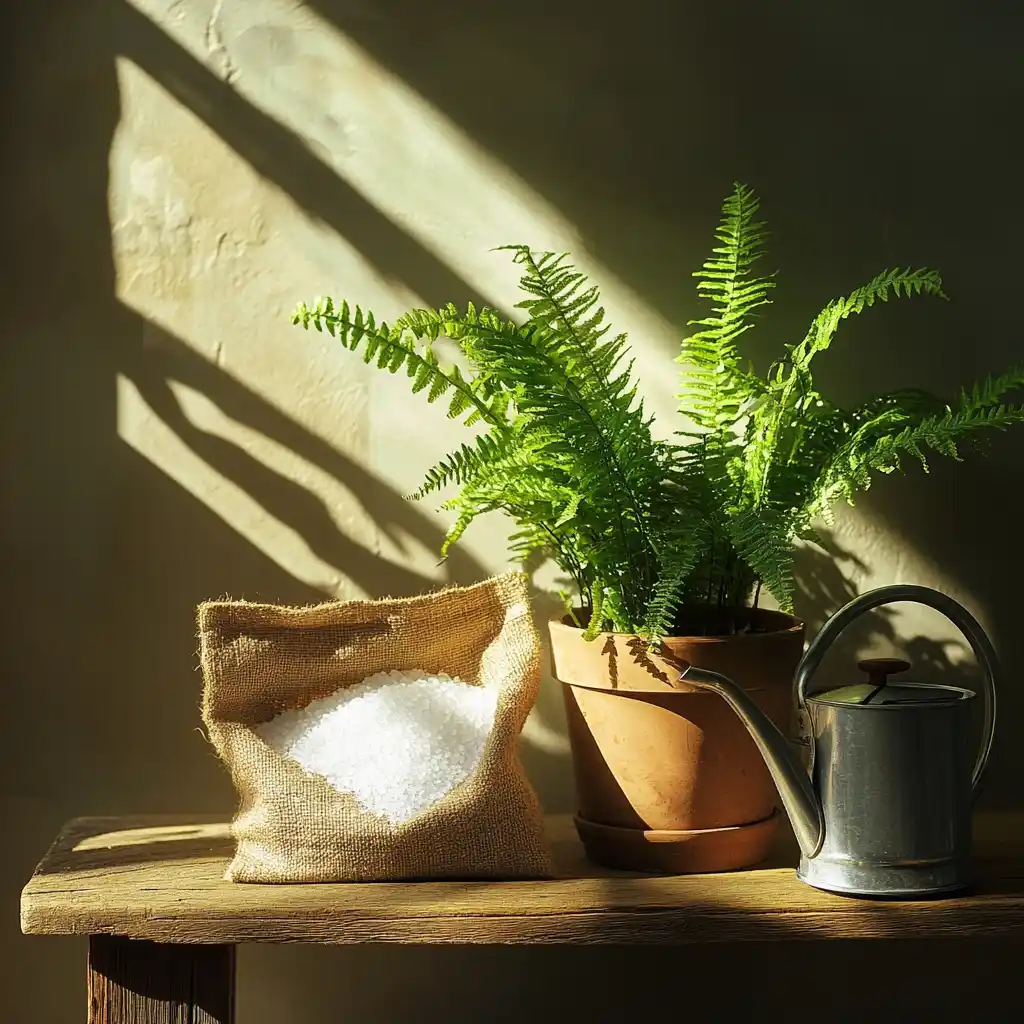
If you want fuller, more vibrant fronds, a little nutritional boost can go a long way. One of the easiest and most effective tricks for outdoor fern care in pots is to fertilize monthly with Epsom salt — a natural and affordable solution that encourages strong, healthy growth.
Why Epsom Salt Works
Epsom salt contains magnesium and sulfur, two essential nutrients that ferns need for:
- Greener foliage
- Improved chlorophyll production
- Stronger root systems
These minerals enhance photosynthesis and help your plant absorb other nutrients more efficiently. Many gardeners find that Epsom salt results in noticeably healthier fronds, especially during peak growing season.
How to Apply Epsom Salt to Ferns
- Monthly Mix: Dissolve 1 tablespoon of Epsom salt in a gallon of water.
- Water as Usual: Pour the solution directly into the soil until it runs out of the drainage holes.
- Consistency is Key: Use this method once a month during the spring and summer.
Bonus Tip
You can also pair this with a slow-release fertilizer formulated for foliage plants. This gives your ferns a steady supply of nutrients, while the Epsom salt provides a targeted magnesium boost.
🌱 A well-fed fern is a happy fern — and regular, gentle fertilizing is one of the best ways to keep your ferns in pots looking lush and vibrant.
5. Maintain Proper Moisture and Watering Schedule

One of the biggest secrets to thriving outdoor fern care in pots is consistency — especially when it comes to watering. Ferns love moisture, but not soggy soil. Striking the right balance can mean the difference between lush, thriving fronds and stressed, wilting foliage.
Watering Tips for Healthy Ferns
- Water Daily in Hot Weather
During the peak of summer, especially in dry or windy conditions, potted ferns may need daily watering. In extremely hot climates, twice-daily watering might even be necessary for hanging baskets or small containers. - Keep Soil Evenly Moist
The goal is to keep the soil damp like a wrung-out sponge — moist but never saturated. Overwatering can lead to root rot, while underwatering will cause fronds to droop, dry out, or fall off. - Use Bottom Watering When Possible
If your fern is still in its nursery container, set it in a larger decorative pot and water from the bottom. This encourages deep root growth and prevents water from splashing on the leaves, which can attract pests or cause fungal issues.
Humidity Matters
- Group Plants Together: Creating a small cluster of potted plants increases humidity in the immediate area.
- Misting Can Help: Light misting in the morning can refresh fronds, but avoid heavy overhead watering, which may cause mildew.
🌡️ Ferns have dense root systems and need their environment to be humid and moist, not dry and brittle. Monitor the soil often and adjust your watering schedule based on the weather and season.
6. Inspect for Pests and Sun Damage
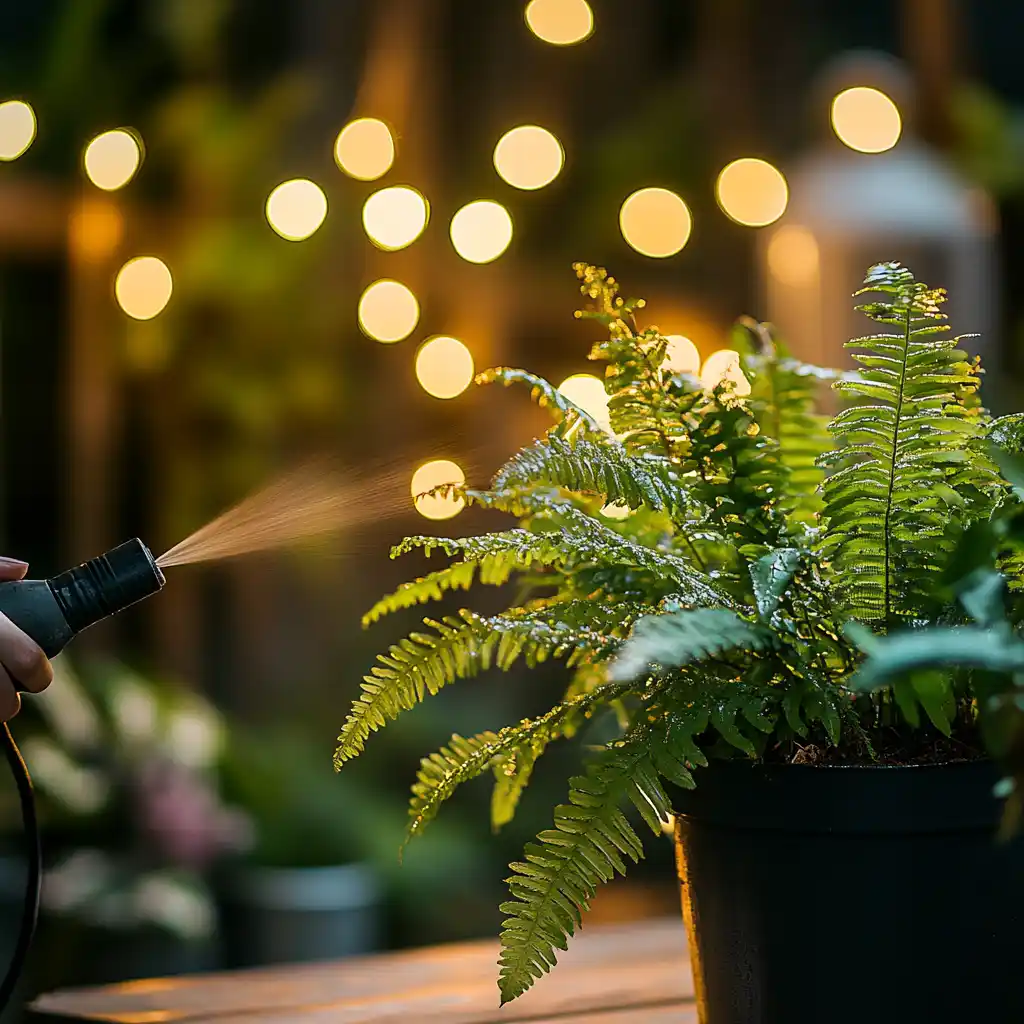
Routine checks are a simple yet powerful part of maintaining healthy ferns in pots. Even though ferns are relatively low-maintenance, they can still fall victim to pests or environmental stress if not monitored regularly.
What to Watch For
- Pests and Insects
While not commonly plagued by infestations, ferns can occasionally attract pests like spider mites, aphids, or scale. Look for:- Tiny bugs on the underside of leaves
- Webbing or sticky residue
- Clusters of small eggs or white spots
- Sun Damage Symptoms
If your once vibrant green fronds begin to look dull, yellow, or scorched, your fern may be getting too much direct sunlight. Signs include:- Browning leaf tips
- Faded or yellowed fronds
- Wilted appearance despite adequate watering
Bonus Observation Tips
- Rotate your pots occasionally for even growth.
- Remove dead or damaged fronds to encourage new growth.
- Check the soil level — if it looks compacted or dry at the top, it’s time to refresh or rehydrate.
🪴 Regular inspections ensure your outdoor fern care in pots is proactive rather than reactive — and your plants will reward you with long-lasting, lush beauty.
Frequently Asked Questions (FAQ)

1. How often should I water ferns in pots outdoors?
Watering frequency depends on your climate, but during hot summer months, potted ferns often require daily watering. The goal is to keep the soil consistently moist — not soggy. In cooler weather or shaded areas, you may only need to water every 2–3 days.
2. What’s the best location to place outdoor potted ferns?
Ferns thrive in bright, indirect light. Ideal spots include covered porches, patios with morning sun, or areas shaded by trees. Avoid placing them in direct afternoon sunlight, as it can scorch their fronds.
3. Can I leave my potted ferns outside during the winter?
It depends on the fern type and your hardiness zone. In colder climates, most tropical ferns (like Boston or Macho ferns) need to be brought indoors or treated as annuals.
4. How can I tell if my fern is getting too much sun?
Signs include yellowing or browning fronds, crispy edges, or faded foliage. If you notice these symptoms, relocate the plant to a shadier, more protected area with filtered light.
5. Do I need to fertilize outdoor ferns in pots?
Yes. Monthly feeding with diluted Epsom salt water provides magnesium and promotes lush green growth. You can also add a slow-release fertilizer during the growing season for added nutrients.
6. What type of soil should I use for potted ferns?
Use a well-draining, peat-based potting mix. You can enhance it with perlite or fine bark to improve aeration. Avoid heavy soils that retain water, as ferns dislike soggy roots.
Conclusion
With the right approach, outdoor fern care in pots becomes an easy and rewarding part of your gardening routine. Choosing the right varieties for your zone, providing ideal lighting, and using breathable containers with consistent moisture management will set your plants up for long-term success.
Even low-maintenance greenery benefits from a little ongoing attention. Monthly feeding, regular checkups for pests, and adjustments to sun exposure can go a long way in keeping your porch or patio display lush and thriving throughout the season.
Whether you’re styling a shaded balcony, updating your entryway, or creating a cozy backyard retreat, mastering outdoor fern care in pots brings texture, freshness, and timeless beauty to your outdoor spaces — all with minimal effort.
🌿 Love gardening inspiration? Follow me on Pinterest for bold plant ideas, tips, and seasonal color!
More Posts
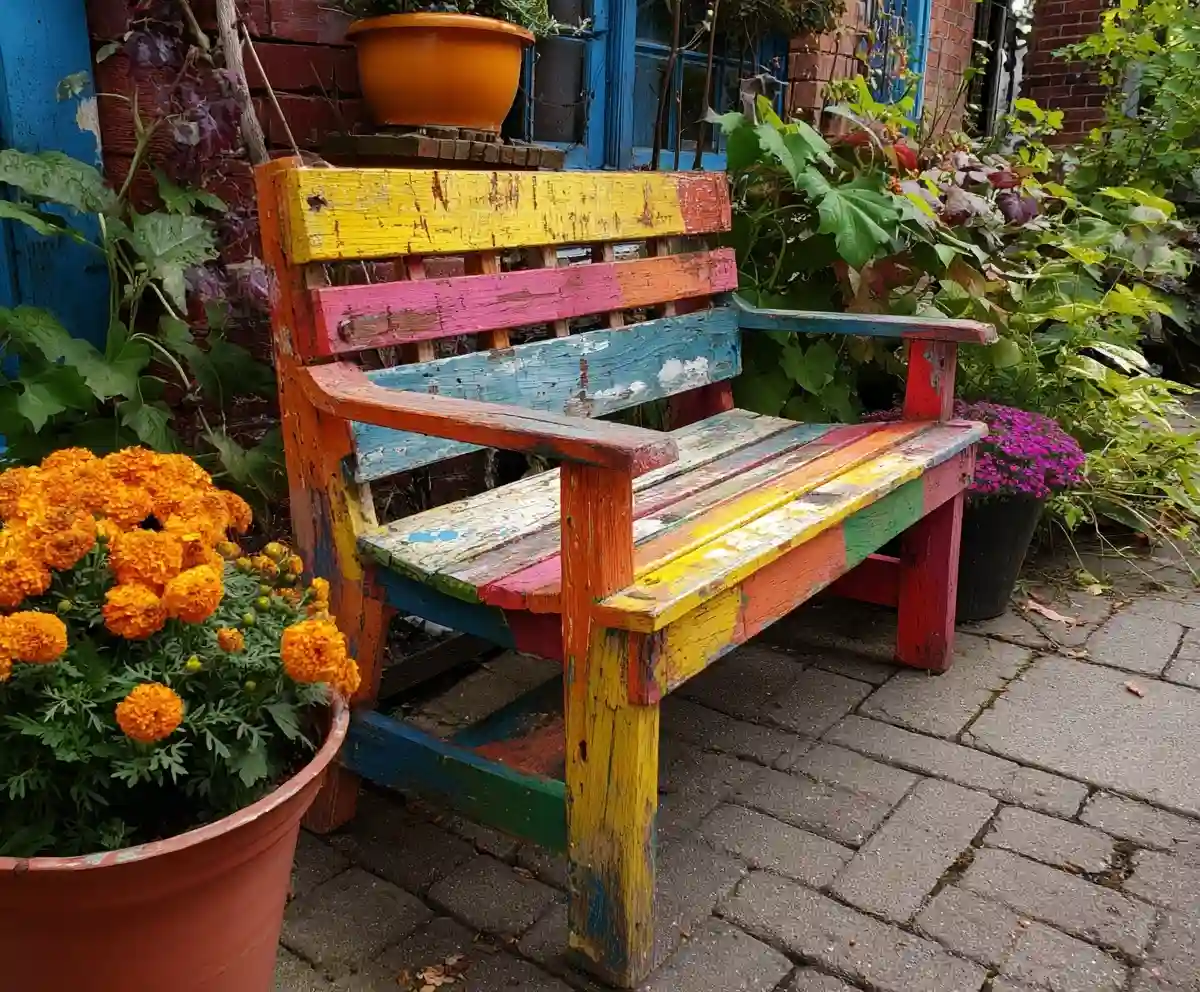
19+ Budget-Friendly Backyard Makeover Ideas
Backyard makeover ideas can turn even the most ordinary outdoor space into a warm, inviting retreat—without draining your wallet.
Read More →
21 Stunning & Simple DIY Clematis Trellis Designs
DIY clematis trellis designs are a beautiful way to blend creativity with function in your garden.
Read More →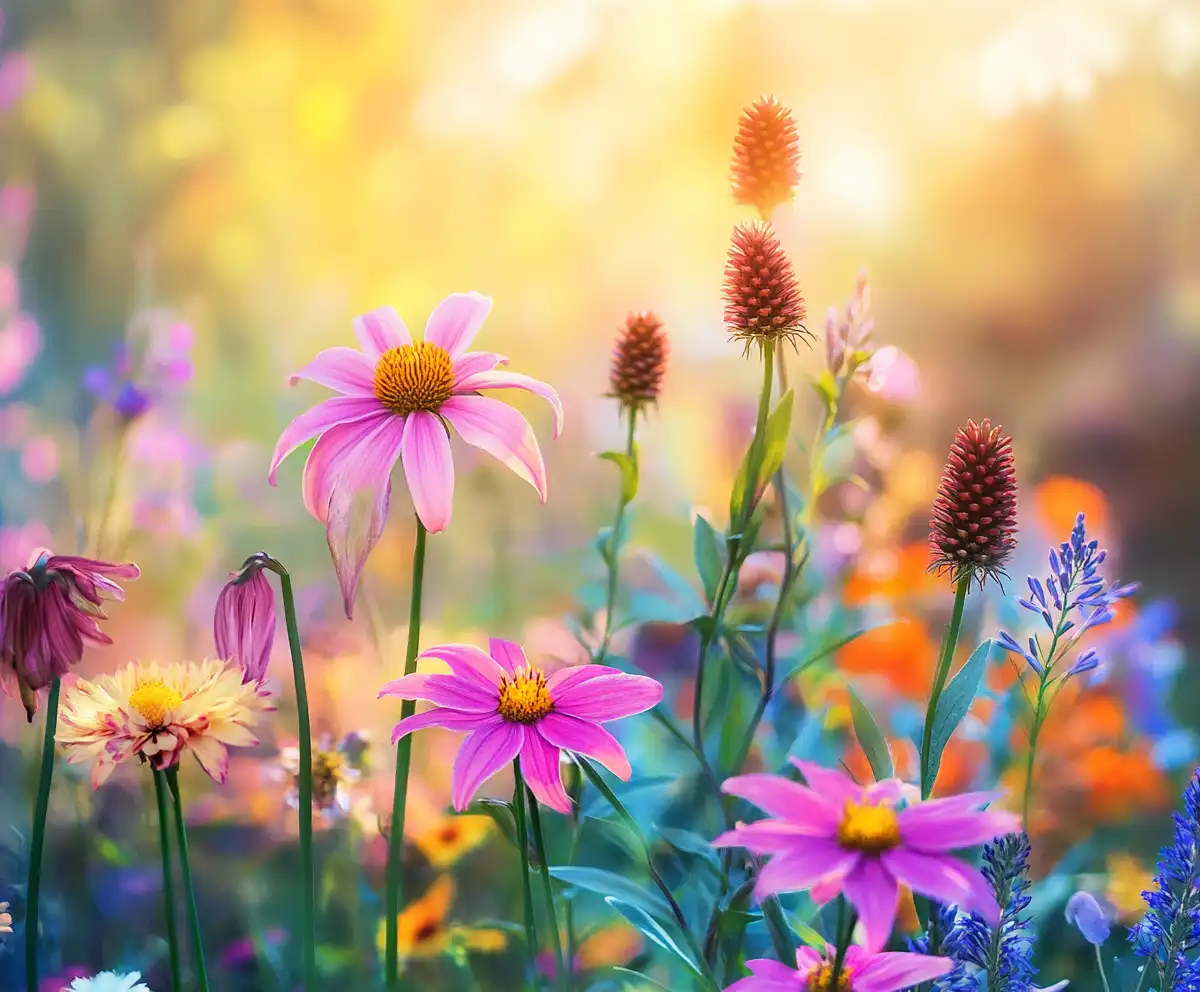
12 Full Sun Perennials That Bloom All Summer
Explore a selection of hardy perennials that flourish and bloom beautifully in full sun throughout the summer.
Read More →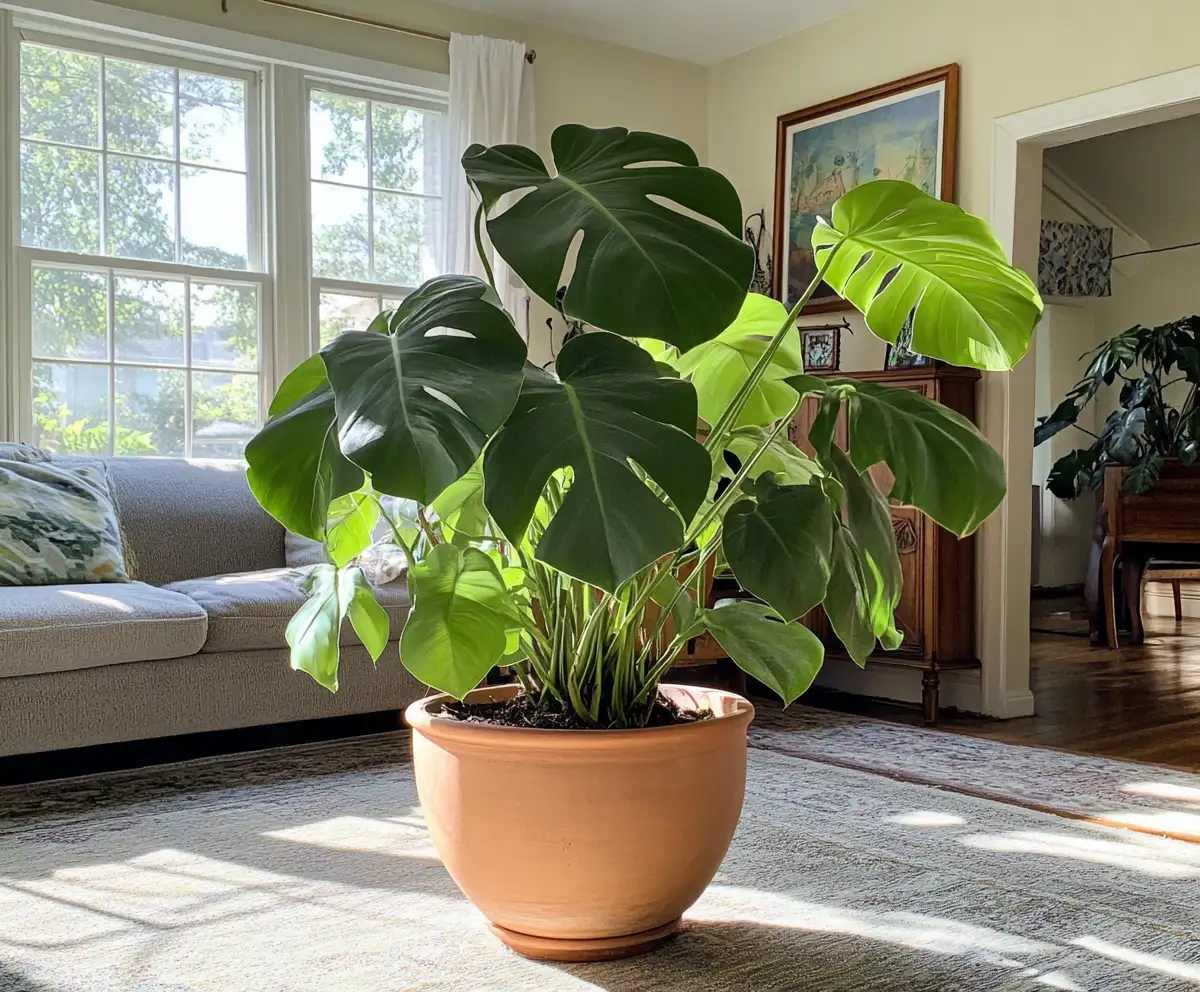
Houseplants for Living Room
Find the perfect houseplants to brighten and purify your living room while adding a touch of nature indoors.
Read More →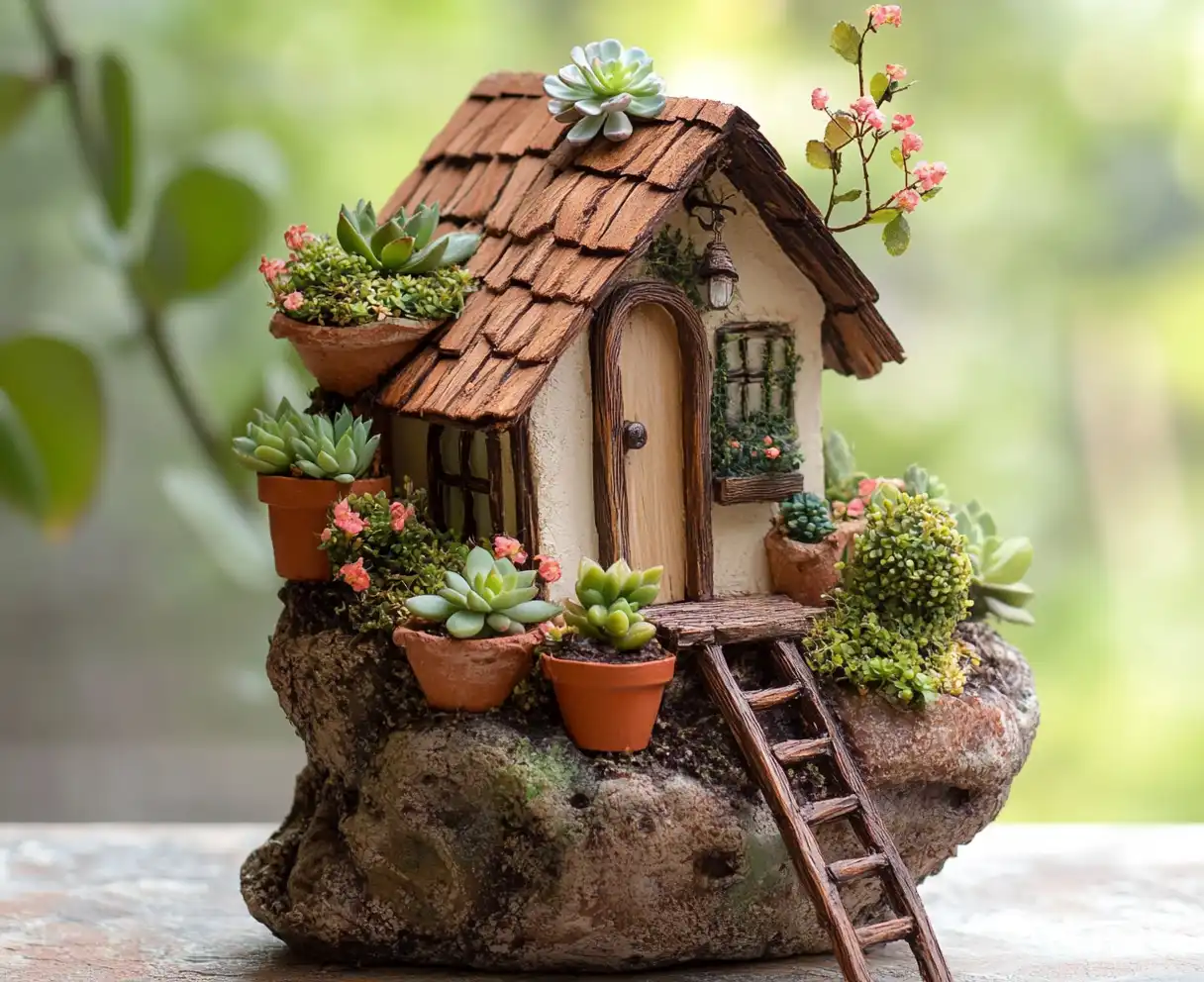
Backyard Play Area for Kids
Create a fun and safe backyard play area for kids with these inspiring design ideas and tips.
Read More →
Top Privacy Trees
Discover top tree varieties that provide natural privacy and enhance your outdoor space.
Read More →

